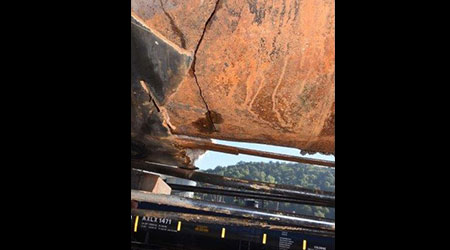 The incident occurred when 178,000 pounds of liquefied compressed chlorine was released over two-and-a-half hours after a DOT-105 tank car sustained a 42-inch crack in its tank shell.Photo – NTSB accident report
The incident occurred when 178,000 pounds of liquefied compressed chlorine was released over two-and-a-half hours after a DOT-105 tank car sustained a 42-inch crack in its tank shell.Photo – NTSB accident reportThe National Transportation Safety Board (NTSB) yesterday issued five safety recommendations following its investigation of an August 2016 chlorine release from a ruptured tank car near New Martinsville, West Virginia.
Eight people were injured in connection with the accident, in which 178,000 pounds of liquefied compressed chlorine was released over two-and-a-half hours after a DOT-105 tank car sustained a 42-inch crack in its tank shell. The crack occurred shortly after the car was loaded at the Axiall Corp. Natrium plant, according to an NTSB press release.
As a result of its investigation, the NTSB issued three new safety recommendations to the Pipeline and Hazardous Materials Safety Administration (PHMSA), and one each to the Association of American Railroads (AAR) and American Railcar Industries Inc. (ARI).
The NTSB also reclassified safety recommendation R-04-7 issued to the Federal Railroad Administration from "Open-Acceptable Response" to "Closed-Acceptable Action/Superseded" by safety recommendation R-19-001, which is one of the three issued to PHMSA yesterday.
The agency wants the AAR to ensure local post-weld heat treatment processes are sufficiently monitored to avoid damage to tank-car materials. Inspection and maintenance procedures to address cracks in cradle pad weld attachments is the focus of the NTSB's recommendation to ARI.
Recommendations to the PHMSA call for:
• promulgation of a final standard that includes enhanced fracture toughness requirements for tank heads and shells for pressure tank cars used to transport poison inhalation hazard/toxic inhalation hazard materials;
• prohibiting use of tank cars to transport poison inhalation hazard/toxic inhalation hazard materials that are constructed of non-normalized steels and are not constructed of steels meeting the highest available fracture toughness specifications; and
• maintenance guidance for owners of DOT-105 pressure tank cars transporting poison inhalation hazard/toxic inhalation hazard materials to establish structural integrity inspection frequency, define critical flaw size, repair and acceptance criteria for fracture-sensitive locations and nondestructive testing methods to detect and identify cracks.
The full accident report is available here.
Contact Progressive Railroading editorial staff.